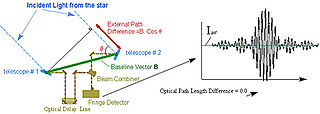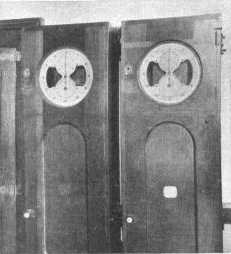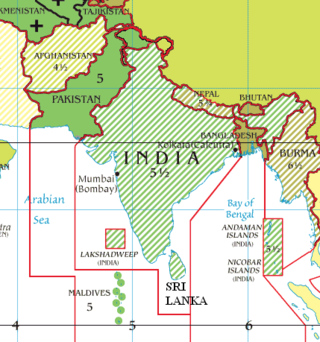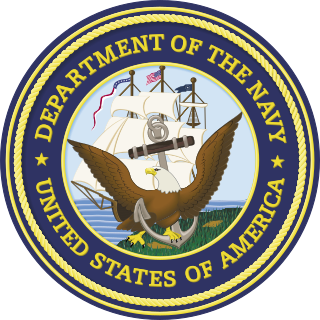
Astrometry is a branch of astronomy that involves precise measurements of the positions and movements of stars and other celestial bodies. It provides the kinematics and physical origin of the Solar System and this galaxy, the Milky Way.
A time standard is a specification for measuring time: either the rate at which time passes or points in time or both. In modern times, several time specifications have been officially recognized as standards, where formerly they were matters of custom and practice. An example of a kind of time standard can be a time scale, specifying a method for measuring divisions of time. A standard for civil time can specify both time intervals and time-of-day.
Universal Time is a time standard based on Earth's rotation. While originally it was mean solar time at 0° longitude, precise measurements of the Sun are difficult. Therefore, UT1 is computed from a measure of the Earth's angle with respect to the International Celestial Reference Frame (ICRF), called the Earth Rotation Angle. UT1 is the same everywhere on Earth. UT1 is required to follow the relationship

The United States Naval Observatory (USNO) is a scientific and military facility that produces geopositioning, navigation and timekeeping data for the United States Navy and the United States Department of Defense. Established in 1830 as the Depot of Charts and Instruments, it is one of the oldest scientific agencies in the United States, and remains the country's leading authority for astronomical and timing data for all purposes.

The Defense Information Systems Agency (DISA), known as the Defense Communications Agency (DCA) until 1991, is a United States Department of Defense (DoD) combat support agency composed of military, federal civilians, and contractors. DISA provides information technology (IT) and communications support to the President, Vice President, Secretary of Defense, the military services, the combatant commands, and any individual or system contributing to the defense of the United States.
Time and frequency transfer is a scheme where multiple sites share a precise reference time or frequency. The technique is commonly used for creating and distributing standard time scales such as International Atomic Time (TAI). Time transfer solves problems such as astronomical observatories correlating observed flashes or other phenomena with each other, as well as cell phone towers coordinating handoffs as a phone moves from one cell to another.

A time signal is a visible, audible, mechanical, or electronic signal used as a reference to determine the time of day.

WWV is a shortwave radio station, located near Fort Collins, Colorado. It has broadcast a continuous time signal since 1945, and implements United States government frequency standards, with transmitters operating on 2.5, 5, 10, 15, and 20 MHz. WWV is operated by the U.S. National Institute of Standards and Technology (NIST), under the oversight of its Time and Frequency Division, which is part of NIST's Physical Measurement Laboratory based in Gaithersburg, Maryland.

William Markowitz was an American astronomer, principally known for his work on the standardization of time.

Indian Standard Time (IST), sometimes also called India Standard Time, is the time zone observed throughout India, with a time offset of UTC+05:30. India does not observe daylight saving time or other seasonal adjustments. In military and aviation time, IST is designated E* ("Echo-Star"). It is indicated as Asia/Kolkata in the IANA time zone database.

Standard time is the synchronization of clocks within a geographical region to a single time standard, rather than a local mean time standard. Generally, standard time agrees with the local mean time at some meridian that passes through the region, often near the centre of the region. Historically, standard time was established during the 19th century to aid weather forecasting and train travel. Applied globally in the 20th century, the geographical regions became time zones. The standard time in each time zone has come to be defined as an offset from Universal Time. A further offset is applied for part of the year in regions with daylight saving time.

The United States Naval Criminal Investigative Service (NCIS) is the primary investigative law enforcement agency of the U.S. Department of the Navy. Its primary function is to investigate major criminal activities involving the Navy and Marine Corps, though its broad mandate includes national security, counterintelligence, counterterrorism, cyberwarfare, and the protection of U.S. naval assets worldwide. NCIS is the successor organization to the former Naval Investigative Service (NIS), which was established by the Office of Naval Intelligence after the Second World War.
The International Celestial Reference System (ICRS) is the current standard celestial reference system adopted by the International Astronomical Union (IAU). Its origin is at the barycenter of the Solar System, with axes that are intended to "show no global rotation with respect to a set of distant extragalactic objects". This fixed reference system differs from previous reference systems, which had been based on Catalogues of Fundamental Stars that had published the positions of stars based on direct "observations of [their] equatorial coordinates, right ascension and declination" and had adopted as "privileged axes ... the mean equator and the dynamical equinox" at a particular date and time.
A United States defense standard, often called a military standard, "MIL-STD", "MIL-SPEC", or (informally) "MilSpecs", is used to help achieve standardization objectives by the U.S. Department of Defense.
The Timation satellites were conceived, developed, and launched by the United States Naval Research Laboratory in Washington, D.C. beginning in 1964. The concept of Timation was to broadcast an accurate time reference for use as a ranging signal to receivers on the ground. On 31 May 1967, the Timation-1 satellite was launched. This was followed by the Timation-2 satellite launch in 1969. The results of this program and Air Force Project 621B formed the basis for the Global Positioning System (GPS). The Navy's contribution to the GPS program continued to be focused on ever more accurate clocks.


A master clock is a precision clock that provides timing signals to synchronise slave clocks as part of a clock network. Networks of electric clocks connected by wires to a precision master pendulum clock began to be used in institutions like factories, offices, and schools around 1900. Modern radio clocks are synchronised by radio signals or Internet connections to a worldwide time system called Coordinated Universal Time (UTC), which is governed by primary reference atomic clocks in many countries.
Time synchronization in North America can be achieved with many different methods, some of which require only a telephone, while others require expensive, sensitive, and rare electronic equipment. In the United States, the United States Naval Observatory provides the standard of time, called UTC(USNO), for the United States military and the Global Positioning System, while the National Institute of Standards and Technology provides the standard of time for civil purposes in the United States, called UTC(NIST).
Gernot Maria Rudolph Winkler was responsible for the Time Service Department of the United States Naval Observatory (USNO) from 1966 to 1996.











